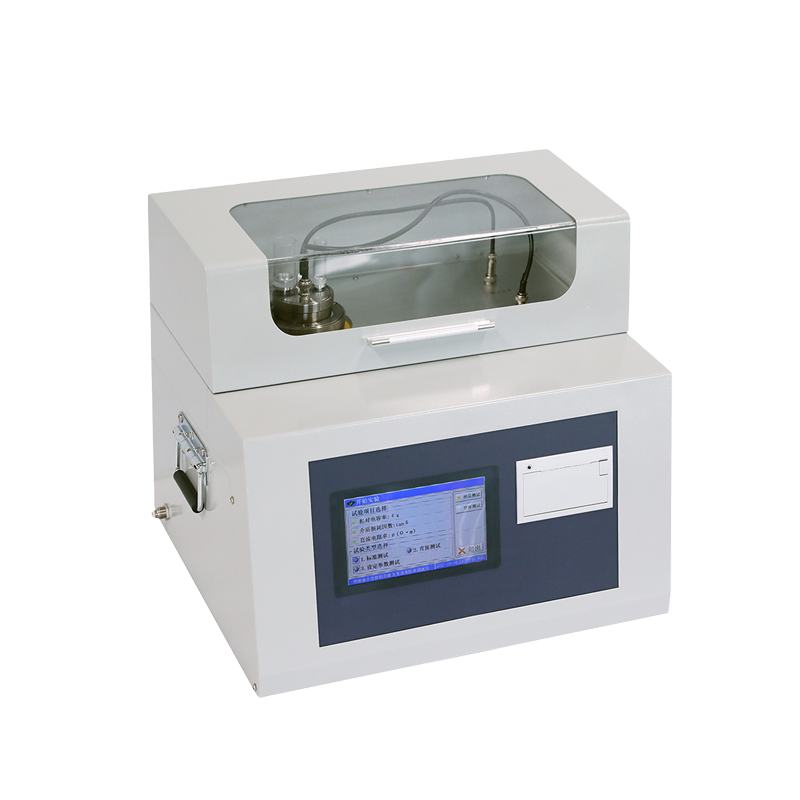The recovered unfiltered oil medium is called inferior oil, which contains a lot of water and impurities, and its dielectric strength is mostly below 12KV. Especially for low-quality oil with a lot of water, some users use a high-dielectric strength tester to test it in order to know how bad it is. As a result, the high-voltage test system of the dielectric strength tester for insulating oil is easily damaged.
Normally, the space between the high voltage electrodes is filled with insulating oil. During the test, the voltage between the two electrodes continues to increase, and oil media with different insulation strengths can withstand high-voltage electric fields of different values. This rising high-voltage electric field causes the insulating oil media to be suddenly broken down when it cannot withstand it. The large current is collected by the instrument and immediately shuts down and loses high voltage and turns to step-down operation.

GD6100D Insulation oil Tan Delta Tester
When testing poor-quality oil with heavy water content, the voltage between the electrodes of the two hemispheres continues to rise, and at the same time, the water particles in the oil medium are absorbed into the gap between the balls under the action of a high-voltage electric field to form a pale white mist-like water column. Thickened, the water resistance is getting smaller and smaller. This kind of transient process in which the water resistance becomes smaller and the current of the high-voltage transformer increases (without breakdown and sudden discharge) will cause damage to the instrument, the current limiting resistor, the fuse will burn out, and even the high-voltage transformer of the instrument will be burned.
Test of low pressure oil medium
This kind of oil medium is usually at 15~35KV. Even if the oil medium contains a small amount of water and impurities, the instrument can still test normally. It only shows that some bubble particles (or impurities) are adsorbed to the gap between the balls to generate discharge during the boosting process. The air bubbles are broken up and extruded from the gap between the balls, and the oil is replenished, so the pressure continues to increase until the maximum bearing point of the oil medium is broken down. This kind of test data is still reliable.
The test of inferior oil
When recovering the oil medium to be filtered, such as water drops or impurities that can be seen with the naked eye, it is best not to forcefully use instruments for testing. In the inferior oil medium that has been stored for more than 24 hours, large water droplets sink to the bottom of the oil, and fine particle bubbles float on the top of the oil. The user needs to use non-water-polluted utensils to extract the oil sample in the middle part. During the test, closely observe whether there is a mist column like a thin thread as shown in Figure 9 when the pressure is increased (starting from the initial period of the pressure increase). Turn off the power immediately to stop the test. Or if there are multiple points of continuous discharge during the boosting process, the instrument cannot automatically shut down, and the user should immediately turn off the power supply and stop the test.
Discrimination of test results
In the test, the spark discharge voltage changes in four situations:
(1) The secondary spark discharge voltage is extremely low. The value of this test may be low due to the influence of some external factors brought in by the oil sample into the oil cup or the unclean electrode surface of the oil cup before oil filling. At this time, the average value of 2-6 times can be taken.
(2) The voltage value of the six spark discharges increases gradually, and generally occurs in oil samples that have not been purified or treated thoroughly and have absorbed moisture. This is because the moisture level of the oil is improved after the oil is spark discharged.
(3) The voltage values of the six spark discharges gradually decrease. Generally, it appears in the purer oil of the test, because the generated free charged particles, air bubbles and carbon chips increase successively, which damages the insulation performance of the oil. In addition, some automatic oil testers do not stir during the 6 consecutive tests, and the electrodes between the electrodes The carbon particles gradually increase, resulting in a gradual decrease in the spark discharge voltage.
(4) The spark discharge voltage value is low at both ends and high in the middle. This is normal.
If there is a large dispersion of the withstand voltage value, for example: in the 6 tests conducted according to the preventive test method, the value of one time deviates from other values by a large amount, the value of this time may not be calculated, or the oil sample test shall be taken again. Most likely it is caused by poor oil quality or uneven distribution of free carbon.
Due to the large dispersion of oil withstand voltage test results, if the breakdown voltage is too high (close to 80KV) or the results are the same every time, it means that the instrument may be damaged, please contact the manufacturer.
Post time: Feb-21-2023
